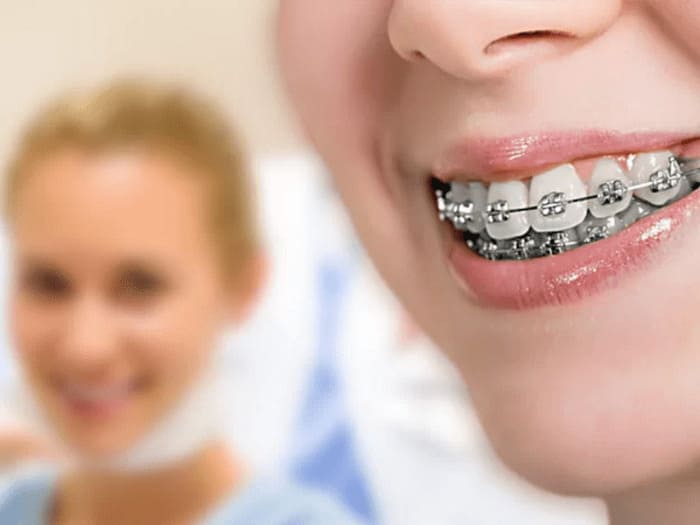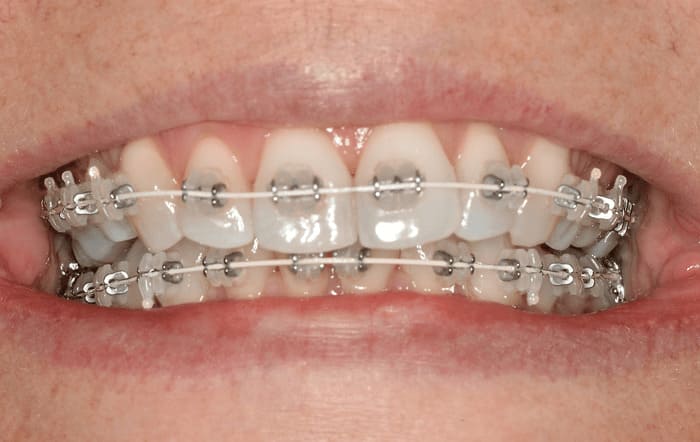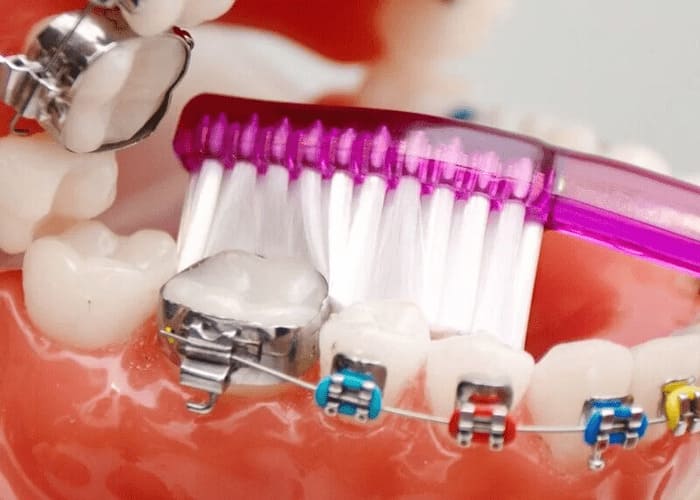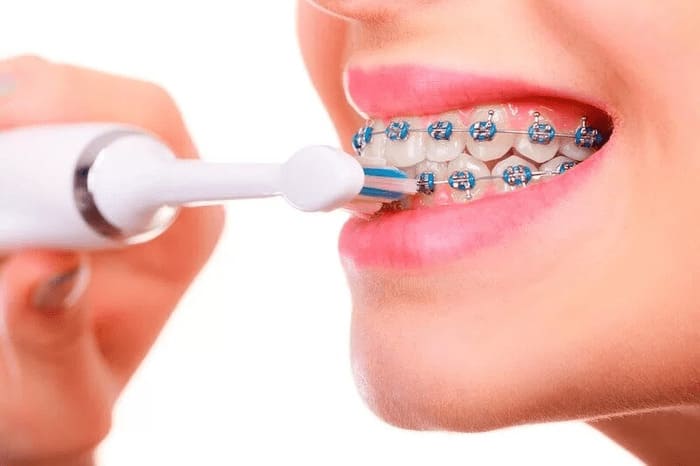How to Take Care of Your Braces?

Contents:
Braces are one of the most popular and effective techniques of bite correction in children and adults. Modern systems are lightweight and comfortable, but your teeth can feel particularly sensitive while adjusting or wearing braces.
To reduce and prevent discomfort, you need to know how to care for the braces and oral cavity properly and how to eat correctly when the braces are fixed. Let’s consider all these questions in this article.

Dental Care Rules
Take care of your teeth regularly, and carefully follow the orthodontist’s instructions.

How to Take Care of Your Braces – what you need to Remember:
- always have a brush or a mono tuft brush at hand;
- brush your teeth for 4 minutes not only twice a day but also every time after eating;
- it is recommended to have an oral irrigator for braces care;
- it is better to check the quality of brushing your teeth with a plaque-disclosing tablet – after the pill is absorbed, the areas with plaque turn blue;
- braces can break off due to sudden temperature changes, so you should avoid taking too hot or too cold food and drinks;
- you should follow a special diet (soft food or finely chopped), avoid drinks that can stain braces or the surrounding areas, and chewing gum.
Even the most thorough home care will not help remove plaque from your teeth thoroughly if you have braces. After placing the system, you must have professional cleaning done 2–4 times a year. The Airflow technique is used with braces. Sodium solution under pressure helps remove soft plaque and calculus while the structure is not displaced or damaged. Ultrasound can be used only near the components of the brace.
Stages of Braces Care
Cleaning braces at home consists of several required steps:
- Take off removable structural elements.
- Thoroughly clean the oral cavity, paying particular attention to hard-to-reach places. Brush gently near the locks without sharp movements or intense pressure. First, brush the upper teeth, then the lower ones.
- Brush the teeth and the structure in horizontal and vertical directions; locks – only vertically.
- Use special toothbrushes. After a regular toothbrush, use a mono-tuft toothbrush. Bring it under the ligature, and thoroughly clean the wire, locks, and each tooth from all sides.
The average duration of the procedure is 20–30 minutes.
Why is it important to take proper care of braces?
Getting used to braces is not an easy process. Immediately after the placement, discomfort and pressure occur. The adjustment period is 3–14 days.

Braces are placed after complete mouth debridement and enamel restoration to prevent the development of cavities. But the braces have a complex design, and many hard-to-reach areas where food debris accumulates. Improper and irregular care can likely cause cavities and other dental diseases.
Consequences of improper brace care:
- plaque forms around the components, in which pathogenic microorganisms multiply – white spots appear on the enamel;
- the gums become inflamed, swollen, and bleed;
- in case of an infectious or inflammatory process, correcting the braces’ position on time is impossible, and the duration of orthodontic treatment increases.
Braces need to be examined daily to notice damage or displacement of the braces in time. If the components slip or wobble with light finger pressure, you should immediately contact an orthodontist.
How to keep track of dental hygiene?
With orthodontic treatment, you need to brush your teeth more often. An ordinary toothbrush will not work; you have to purchase special devices.

What you need to take care of your braces:
- Special orthodontic toothbrushes have a soft, thick bristle, and the head size is up to three centimeters. They consist of short bristles for cleaning braces and long bristles for cleaning the surface of the teeth. When using conventional brushes, the bristles move apart, negatively affecting the hygiene procedure’s quality. You can use a rotary or sonic electric toothbrush with soft bristles or orthodontic brush heads.
- Mono tuft brushes are designed to clean hard-to-reach places in the brace system.
- Brush heads are an addition to the mono tuft brush. They remove food particles that accumulate under the braces, around the wire, and between the teeth. They vary by size depending on the intervals between the teeth. The universal size is different for everyone. Models with stiff ends, cone-shaped or curved bristles are suitable for braces. They are rotated under a wire to remove plaque and food debris.
- An oral irrigator is the most convenient device for cleaning braces. Jets of water under high-pressure wash away plaque and food debris even from the narrowest places of the system. There is a special orthodontic nozzle equipped with soft bristles.
- Floss (dental floss) for cleaning the space between the teeth. They differ in thickness and shape. Flat flosses are necessary if the teeth are tightly fitted to each other, and round flosses – if there is a considerable distance between the units of the dentition. Ribbon ones are used if there are gaps. Superfloss is made of a stiff end, a piece of ordinary thread, and a wide sponge fiber. It cleans dentures and braces best of all.
- Toothpaste – remineralizing, containing 1250-1450 ppm fluoride. Before placing braces, you must undergo a course of applications with mineral gel to strengthen the enamel. You can also use wires with an antiseptic effect to destroy bacteria accumulating on the damaged mucous membrane. It is necessary to change toothpaste periodically.
- Rinses – freshen breath, and have a therapeutic effect. Essential oils of menthol and eucalyptus destroy bacteria. You should avoid using solutions with alcohol while wearing braces. Products with chlorhexidine are good antiseptics that prevent the development of inflammatory processes in the oral cavity. Fluoride strengthens enamel and reduces the risk of cavities.
- Foams – do not contain alcohol and aggressive substances. They are used if you need to brush your teeth urgently.
It is better to immediately buy special orthodontic kits with everything you need and use all the devices to remove braces and lingual systems.
Why do you need braces wax?
Wax or silicone is glued to braces to prevent the mucous membranes from rubbing and reduce pain and discomfort. The substances are safe for the body and do not cause allergic reactions.
How to apply wax to braces – step-by-step instructions:
- Identify problem areas.
- Carry out oral hygiene.
- Dry the waxing areas.
- Separate a small piece of wax, warm it up, and roll it into a ball.
- Attach the wax to the lock or a wire – it should protrude slightly.
- Press the ball to fix it.
- Attach the wax to all problem areas of the braces.
Silicone holds better and lasts longer than wax. The rules for using both substances are identical.
What You Can or Cannot Eat in Braces
A proper diet will help to avoid dental issues and braces breakage. The diet should include foods rich in protein, calcium, magnesium, fluorine, phosphorus, and vitamins C and D.
The menu includes dairy products, eggs, fish, meat pates, seafood, vegetables, and leafy greens.

The first 3–5 days after braces are placed, the patient may experience pain, which can be aggravated by eating solid food. The diet during these days: soup stock, soup, smoothies, yogurt, liquid cereals, juice, and jelly.
Baby food suits as well. It is soft and contains essential vitamins and nutrients. Similar nutritional rules should be followed by ligature tightening and archwire replacement.
Foods to avoid:
- nuts, biscuits, seeds, chips, dried fruit, lollipops, caramel, hard fruit, tough meat – can change the tension of the arch wires, lead to structural breakage;
- viscous foods – toffee, chocolate, chewing gum, processed cheese, corn sticks, nougat, caramel, soft bread, and muffins;
- sweets;
- coffee, red wine, and other beverages with dyes, dark grapes, cherries and wild cherries, bitter-berries, mulberries, beets, tomatoes – stain ceramic and plastic braces;
- raspberries, strawberries – tiny seeds get stuck between the structural components;
- cold, hot dishes, drinks – some brace components may become unusable in case of temperature changes.
You should not bite off large pieces of food with braces – excessive mechanical pressure changes the tension of the archwires. Food should be chopped or cut into small pieces. Strength and contact sports are contraindicated for people with orthodontic constructions; they should avoid smoking or drinking alcohol.
After the braces fitting, the orthodontist gives the patient home care instructions. Following all the recommendations carefully will help to avoid braces breaking or coming off, as well as dental problems.

